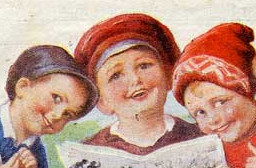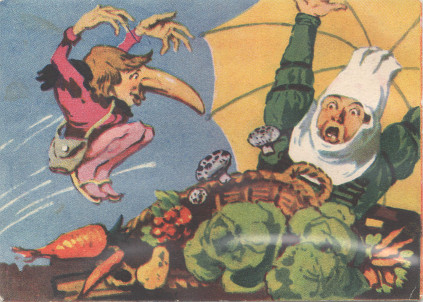
 |
Collector Sammel's online German Cards |
When I first translated the title into English I naively translated it as "Peoples' fairy tales". It seemed an obvious translation as I imagined people sitting around their fires in the evening telling these stories to each other. Then I spoke to Rainer Würgau who has created a site specifically about this album and is more of an expert in these things. He pointed out to me that a lot of the stories could hardly be considered as "fairy" tales. Simply "tales" was a much better translation and I have to agree with him there.
However what about "Völker"? In the 1930s when this album was produced the word "Volk" could be used to mean both "people" and "nation" in the same way that we might refer to a nation as "a people". (The League of Nations was known as the Völkerbund in German). In view of the fact that the stories in the album come from many different countries he considers that "Volk" should be interpreted as "nation". His translation of the title is "Tales of the Nations". However I'm rather unhappy with that translation. For a start, when one reads "THE nations" one immediately asks which nations? Also you might get the impression that the tales are about the nations rather that being from them. I suggested "Tales from the nations" but Rainer was adamant that "der" means "of" and not "from". Whilst it might be a fairly exact translation, it just doesn't "work" in English. We discussed it for a while without coming to any conclusions.
I wondered how one would have understood "die Völker" in 1932. Would it have been understood as "the nations" as Rainer suggests or was that a way of saying "the world"? When you read the album you realise that the tales in it are from all over the world. I think that at the time Reemtsma wanted to present an international selection of tales and so I have translated the title as "Tales from around the world". It's not an exact translation but I think it captures the spirit of what's intended and sounds better in English. It also works as a nice contrast the the album "Deutsche Märchen" (German (fairy) tales) which subsequently replaced this one and illustrates how throughout the 1930s an international outlook was slowly replaced by a more germanic one.
Translation isn't always easy and so you may encounter different English versions of the title. I hope now you will understand what is meant. Just read it and enjoy Stefan Mart's illustrations. Which brings us to the next puzzle.
"Märchen der Völker" proudly announces that it was illustrated by Stefan Mart, giving the impresion that he was well-known in the 1930s. Surprisingly he appears to be unknown and I've not found any references to him apart from this album. Some of the pictures in this set are signed by "Digeer". So was Stefan Mart a pseudonym for an artist called Digeer or vice-versa? Searching through the literature turns up no signs of a Digeer either. Looking in Reemtsma's records to see if there is any correspondence with an illustrator is not possible as the records were all destroyed in the war.
Franz Kathreiner (F.K. = Effka) produced a series of booklets known as Effka Bibliothek (Effka library). This is a series of tales aimed at children and includes some of the same tales as Märchen der Völker. When comparing the pictures there is an astonishing similarity. The pictures were almost certainly drawn by the same person. Unfortunately that doesn't help us any further since there is no indication of who drew the Effka pictures either.
 Looking in
my card collection, I discovered some cards issued around 1930 by the Dr.
Oetker company. For example here is one from the story "Zwerg Nase".
Once again the style of the picture makes it almost certain that it was
drawn by "Stefan Mart". Unfortunately the EFFKA pictures give no
indication of the name of the artist either.
Looking in
my card collection, I discovered some cards issued around 1930 by the Dr.
Oetker company. For example here is one from the story "Zwerg Nase".
Once again the style of the picture makes it almost certain that it was
drawn by "Stefan Mart". Unfortunately the EFFKA pictures give no
indication of the name of the artist either.